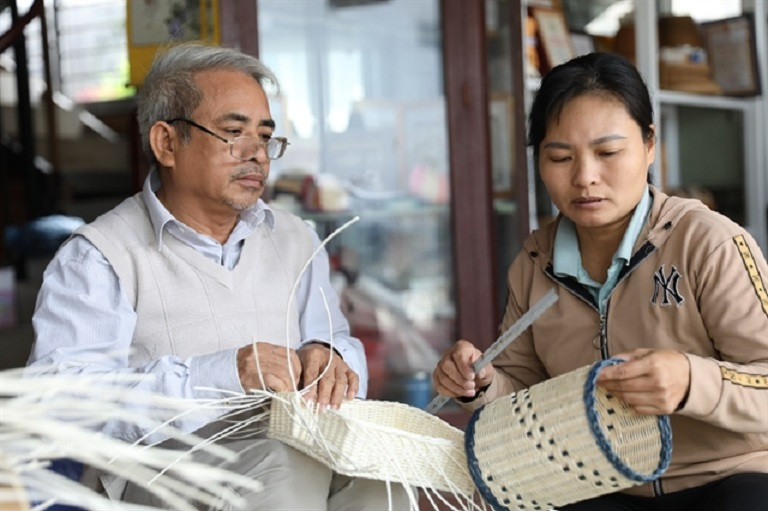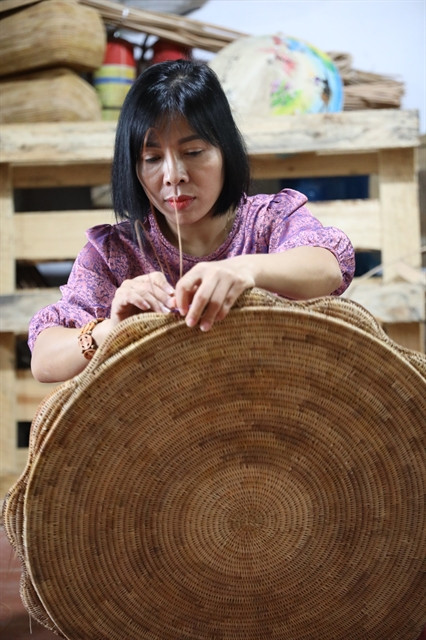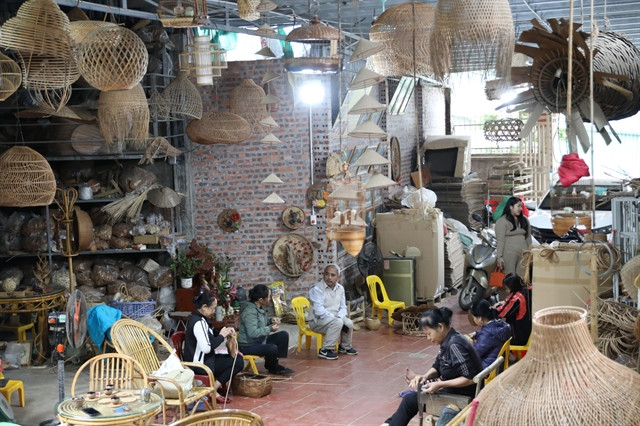
Known as the land of bamboo and rattan wickerwork, Phú Vinh Village has preserved the essence of a craft village through its exquisite products.
With love, passion and creativity, artisans continue the traditional art of weaving and breathe new life into rustic products, creating unique artworks that are highly acclaimed worldwide.
The village is located in Chương Mỹ District, approximately 30km southwest of Hà Nội centre.
As we visit Phú Vinh on a brisk morning, we are enchanted by its peaceful scenery. Despite the passage of time, the village still retains the timeless beauty of a Vietnamese village, with charming old houses, moss-covered communal house roofs, and long-standing workshops, where craftspersons diligently work to create their masterpieces.
Phú Vinh villagers have been proud of their ancient craft, with a history spanning nearly 400 years.
Originally known as Phú Hoa Trang, meaning "God blessed people with skilful hands", the village's inhabitants possess remarkable weaving skills.

From one generation to the next, they have maintained their deep connection to bamboo and rattan, mastering the artistry and understanding the unique properties of these plants. Consequently, the craftsmanship has flourished, becoming an integral part of the village's rich tradition.
Phú Vinh is celebrated for producing high-quality bamboo and rattan wicker products in a staggering variety of types and designs. These include household utensils and furniture, decorations, as well as souvenir and gift items.
"I have been in this profession for about fifty years. Like other artisans, I inherited a treasure trove of weaving techniques from our ancestors. Our generation simply refines and improves these techniques to create more intricate products. We continue to uphold the traditional working style of our ancestors," artisan Nguyễn Văn Tĩnh told Việt Nam News.
"We constantly engage in research and innovation to craft more beautiful and competitive products. Each item is cherished because it is our brainchild."
 |
| Artisan Nguyễn Văn Tĩnh shows his products at the recent Việt Nam Craft Village Festival in Hà Nội. — VNS Photo Thanh Nga |
As the owner of the Việt Quang Rattan and Bamboo Wickerwork company, one of the oldest workshops in the village, Tĩnh believes that their love for their craft and appreciation for their creations stem from the village's enduring tradition.
According to Tĩnh, their attention to detail and commitment to making sophisticated and high-quality products have allowed Việt Quang to conquer the market. The company has received nearly 20 four-star OCOP (One Commune One [Speciality] Product) certifications and won numerous first prizes in contests organised by the Ministry of Agriculture and Rural Development.
Artisan Nguyễn Phương Quang, Tĩnh's son, emphasised, "We combine traditional methods with modern knowledge in designing new products with unique types to cater to tourism and export."
Handcrafted by skilled workers and infused with a passion for their profession, each Phú Vinh product bears the mark of the individual artisan and the spirit of the homeland.
Thanks to the artisans' creativity, rattan and bamboo wicker vases, coasters, trays, and chairs adorned with beautiful patterns have come to life. The fruits of their creative labour have sustained many families and generations in this traditional craft.
"Established during the COVID-19 pandemic, when exporting faced challenges, we shifted our focus to producing environmentally friendly products that emphasise high aesthetic value and creativity. Despite the difficulties posed by the pandemic, we remain committed to our craft," Hoàng Văn Hạnh, the director of the Việt Rattan and Bamboo Wickerwork Company, said.
 |
| A rattan wicker product made by artisan Hoàng Văn Hạnh. — VNS Photo Đoàn Tùng |
Hạnh's family has a long-standing tradition of crafting bamboo and rattan wicker products.
"My father used to craft bamboo and rattan wicker products for King Bảo Đại, such as fans and rattan beds. As the eighth child in the family, I learned the craft from a young age, guided by my parents. As I grew older, I expanded my craftsmanship through interactions with my brothers, friends and colleagues," he said.
Hạnh's oval tea table recently won two first prizes in Vietnamese craft village competitions.
"The tea table showcases the traditional six-sided lattice weaving style. However, through extensive study, I developed a new 3D knitting style," Hạnh explained.
Constantly researching and innovating, Hạnh's workshop has successfully blended ceramics and rattan, infusing new vitality and adding value to traditional bamboo and rattan wicker products.
"I want to combine the products of two traditional craft villages, ceramics and rattan wickerwork, to create something new, so that bamboo and rattan products can be upgraded," said Nguyễn Thị Hân, the wife of Hạnh.
 |
| Nguyễn Thị Hân found her passion in making bamboo and rattan products. — VNS Photo Đoàn Tùng |
Thanks to this creativity, many products from Hạnh's household workshop have been exported overseas, including China, England, France, Germany and the US.
The artisans in Phú Vinh are not limited to creating household objects or decorations; they can also skilfully portray human figures through rattan portraits.
Nguyễn Văn Trung is a leading artisan in this field. With enthusiasm, passion and deft hands, Trung has earned high appreciation from customers for his rattan wicker portraits.
Weaving paintings using fine rattan threads is challenging, and depicting a person's portrait is even more difficult. Carefully refining each slender rattan and bamboo thread, employing up to 15-16 weaving styles, artisans weave the intricate artwork. Furthermore, using only two colours - black and white - the rattan weavers must research, calculate, and knit in a way that captures the soul of the character.
"If the painting is beautiful but doesn't resemble the character, it's useless. If it resembles the character but lacks soul, it's also useless," Trung said.
Tradition runs deep in Phú Vinh. According to Tĩnh, who is also the vice chairman of the Phú Vinh Rattan and Bamboo Craft Village Association, everyone born in the village knows how to make rattan and bamboo wickerwork.
In the past, all households in the village were involved in the craft. Currently about 90 per cent of the villagers continue the trade, and Phú Vinh artisans have spread their skills to many other provinces and cities in Việt Nam. The village is home to 19 nationally recognised master artisans.
"I was born and raised in the village. My brothers and sisters all do this job. We don't have to work outdoors in the sun or rain, and that's why we love our job even more," said 62-year-old Nguyễn Thị Nguyệt.
 |
| Phú Vinh is renowned for its traditional craft of bamboo and rattan weaving, with a history of nearly 400 years. — VNS Photo Đoàn Tùng |
"I am very fortunate to live in Phú Vinh. My husband's family has this ancient craft, and everyone in the family has dedicated themselves to supporting and teaching me in the profession. Later, I developed my own ideas, specialising in jewellery, household utensils, and interior decorations. Some of my products have even won national prizes," Hân said. VNS
 |
| Currently about 90 per cent of the villagers continue the trade. — VNS Photo Đoàn Tùng |